Elizabeth I in Portraiture
For the vast majority of the people of England and Wales, the only knowledge they had of the sovereign was the image on coinage – which was often in short supply. Matters were slightly different in Scotland, where monarchs continued to travel as part of their role in the justice system, but it was still only a small minority of subjects who ever laid eyes on the king.
With the advent of printing, and the rapidly increasing dissemination of books, pamphlets, woodcuts and newsletters, more people than ever before could see a representation of the monarch. Mass printing also coincided with the development of secular portraiture. Prior to the late fifteenth century, paintings of rulers, although not unknown, were rare, and usually confined to a small cameo in a larger religious work. This changed with the advent of geniuses such as Jan van Eyck and Rogier van der Weyden in Burgundy, Leonardo da Vinci, Michelangelo, Raphael, Titian and Bronzino in Italy, Clouet father and son in France, and Cranach, Horenboult, and Holbein father and son in Germany. All these men (and, later in the century, women such as Lavinia Teerlinc and miniaturists Isaac Oliver and Nicholas Hilliard) painted secular portraits of rulers, which, with the new technology of printing could be copied as engravings or woodcuts, and widely shared.
Elizabeth and her court embraced portraiture at every level, and the queen is probably one of the most painted people in history – the National Portrait Gallery alone notes some 135 different images of her, including medals and other artefacts, as well as paintings – not least of which is the rather frightful coronation mug for Queen Elizabeth II from 1953, which has one queen on each side.
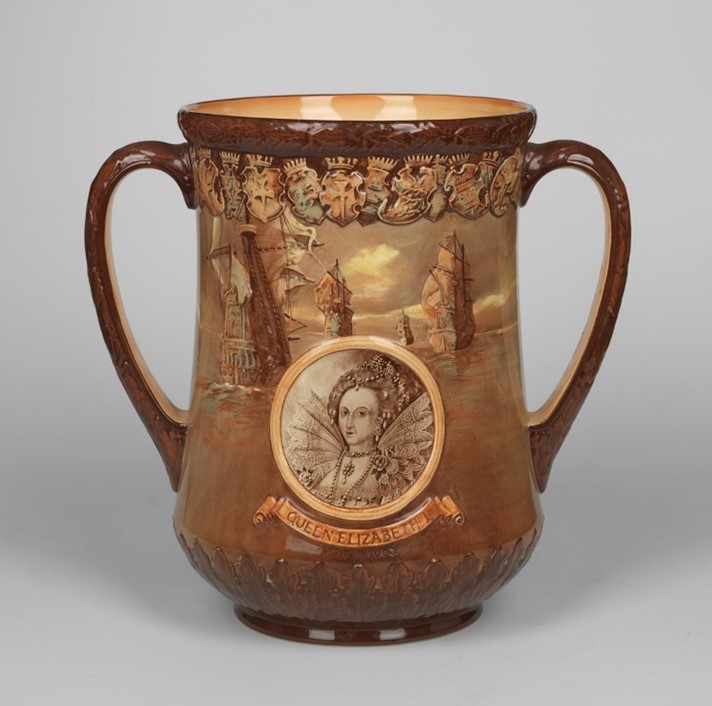
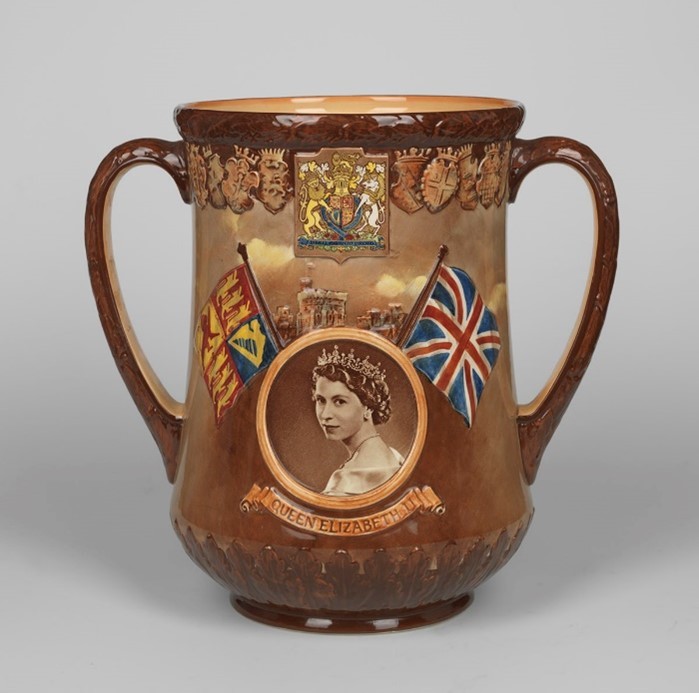
But for Elizabeth, her portraits had a meaning and purpose beyond mere decoration – they were conduits for messages about power, and, as she aged, she controlled the public representations of herself closely, to enhance the cult of Gloriana that grew up to manage the complex political issues that faced a queen with no heir.
The first known portrait of Elizabeth is part of the larger painting known as the Henry VIII’s Succession Portrait at Hampton Court. Elizabeth is shown to the right (from the viewer’s perspective). Unlike Henry, his wife (Jane Seymour painted after her death) and Prince Edward, there is no cloth of estate over her to show rank. She is part of the family, but still tainted with illegitimacy. The first known portrait of her alone, is the famous one in the Royal Collection, attributed to William Scrots, showing Elizabeth at the age of about thirteen holding a prayer book. The face shows a remarkable family likeness to the portrait by Scrots of Edward.
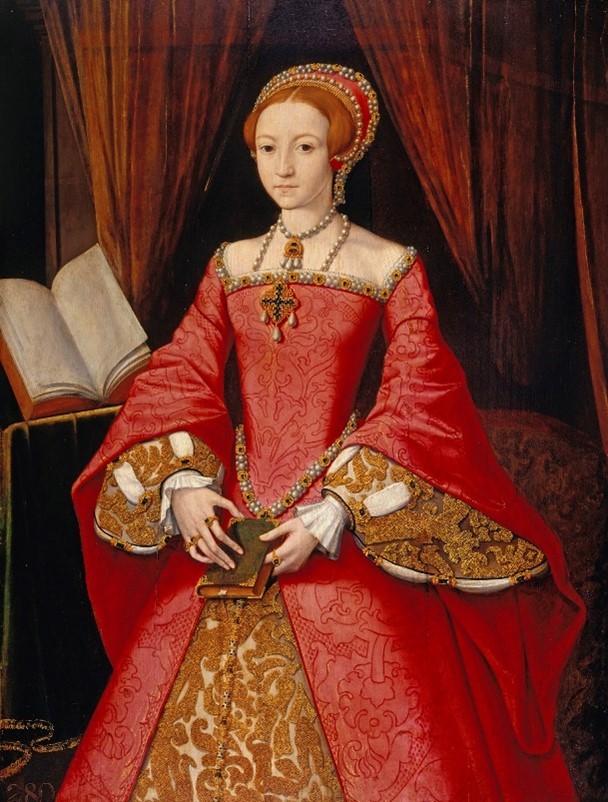
The next known portrait is that of her in coronation garb. The painting known today, and in the National Portrait Gallery, is not the original, but a copy from some fifty years later.
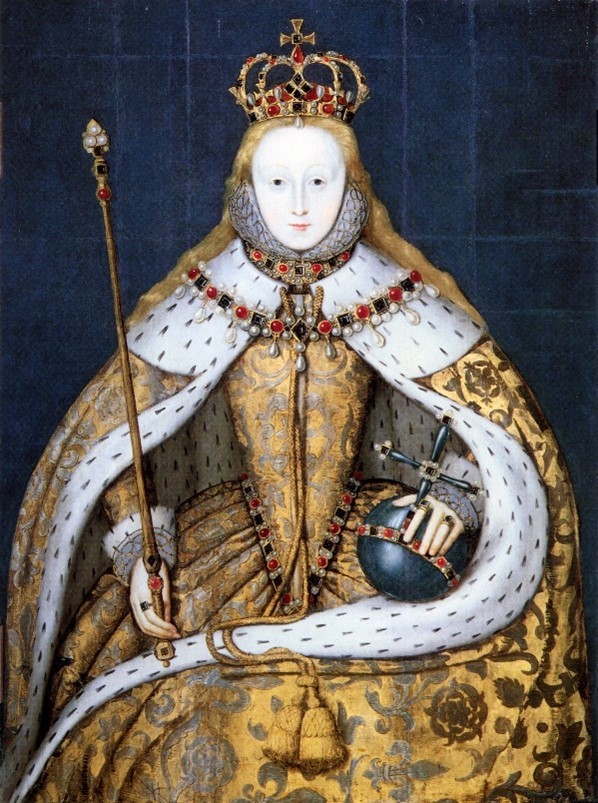
There are a couple paintings from around 1560 - 65, known as the Clopton Type, as one was originally in the possession of the Clopton family. Compared with later portraits, these are surprisingly plain – although it should be noted that all the black stones in sixteenth century portraits are not, as may be supposed, onyx, but diamonds. The fashion was to put them on a black background. The bible or prayer book in her hand is intended as a strong indication of Protestantism, whilst the rather oddly shaped mouth suggests either toothache, or a mediocre artist.

It may have been the poor quality of paintings that led, in 1563, to the queen’s secretary, Sir William Cecil, drafting a proclamation prohibiting any artist or engraver from making a likeness of the queen until ‘some special conning [skilful] payntor might be permitted by access to hir Majesty to take the naturall representation of hir Majesteyes wherof she hath been allweise of hir owne reall [royal] disposition very unwyllyng.’ Once this had been done, the proclamation continued, other artists of all sorts would be able to ‘follow the sayd…portraictur.’ In her book on Hilliard, Elizabeth Goldring speculates that this order came from Elizabeth herself, who had been embarrassed by having to send bad pictures to foreign courts, although she also notes that it is unknown whether the proclamation were ever issued.
In the late 1560s and early 1570s, perhaps to re-emphasise Elizabeth’s just claim to the throne after the Rising of the North, and her virtues as a ruler, two allegorical paintings appeared. The first, which appears in two versions, dates from c. 1569, and shows Elizabeth with the Three Goddesses. She is holding the golden apple, and the goddesses are overcome – suggesting that the queen is more beautiful, wiser, and more chaste than any of them. The painting has been attributed to Hans Eworth, but Sir Roy Strong, the acknowledged expert, identifies the artist as Hoefnagel. The second version is a miniature, by Isaac Oliver, and based on the dress, dates from the 1580s – it only came to light in around 2013.
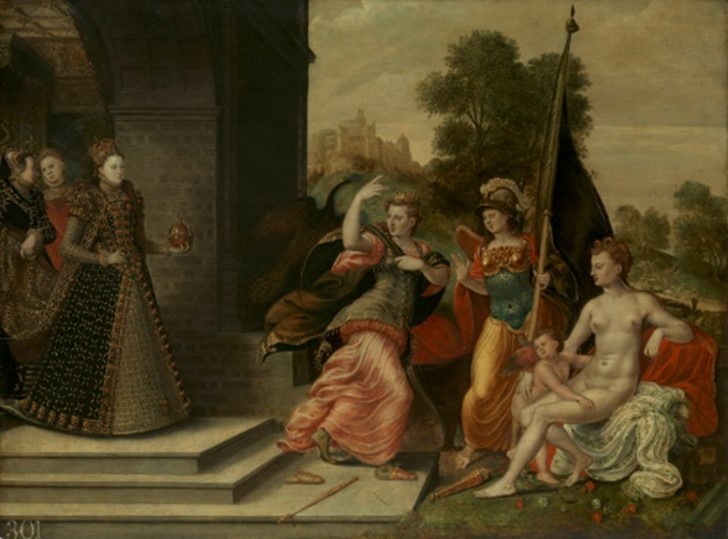
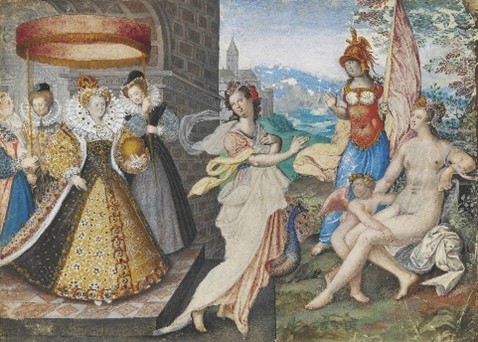
The other, the Allegory of the Royal Succession from 1570, was presented to Sir Francis Walsingham for part of his embassy to France. More on that here. A later version of this painting updates Elizabeth’s dress to that of the 1590s.
In these portraits and the others of the early to mid-1570s, such as Hilliard’s miniatures and his attributed Pelican Portrait (housed at the Walker Art Gallery, in Liverpool) and Phoenix Portrait (National Portrait Gallery, London), Elizabeth is still recognisable as an individual, even though her costumes are becoming more elaborate. Her robes are becoming encrusted with jewels, which often have symbolic meanings and reflect the growing feeling that Elizabeth the individual embodied the English state in a conflation of the widely accepted idea that monarchs had two selves – one private and one public. In the Pelican portrait, her breast is adorned with the symbol of ‘the pelican in her piety’ – that is, a pelican piercing its own breast to produce blood to feed its offspring. Presumably, the underlying message was that Elizabeth would sacrifice herself for her people. Her dress is heavily worked with pearls, symbols of purity. Although the cult of Elizabeth personification as the Virgin Queen was in its infancy (as she was still claiming that marriage might be a real possibility at this time), chastity was an important attribute for an unmarried queen to exhibit.
The Phoenix portrait, from the same period, and even painted on wood panels from the same oak trees is a mirror image. The queen’s dress is very similar, although black, rather than red, and she again has a brooch which displays a mythological bird – this time the phoenix, which is also a symbol of chastity, being reborn from its own ashes rather than through more conventional methods of procreation. The same imagery of the phoenix is used in another of Hilliard’s works – the Phoenix jewel.
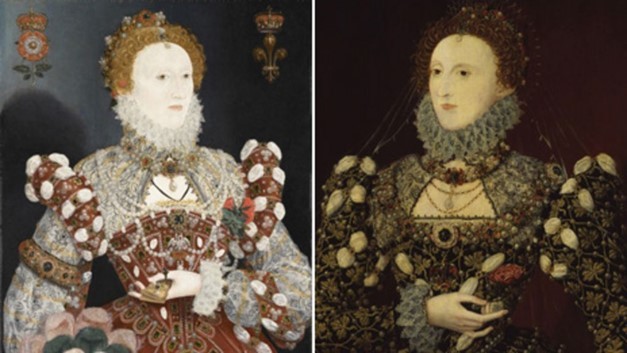
As well as Hilliard, new talent both native to, or visiting, England, produced more renditions of Elizabeth in the late 1570s, slowly becoming more idealised. One of the most recognisable is that known as the Darnley Portrait (c. 1575), sometimes attributed to the Italian mannerist painter, Federico Zuccaro, although the National Portrait Gallery’s most up-to-date analysis suggests a Netherlandish artist. The portrait is considered likely to have been painted from life, so gives a good impression of how Elizabeth looked when she was in her late forties, allowing for some probable softening of any signs of her battle with small-pox in 1563. The jewel hanging from her waist is a ruby, with images of Minerva, Jupiter, Venus, Cupid and Mars. The crown to the right is apparently a latter addition.
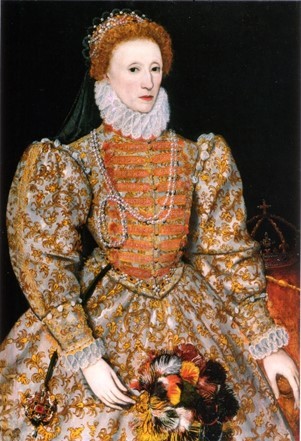
From around the turn of the 1580s, several versions of a type called the Sieve Portrait are extant. In two of them Elizabeth’s red dress has the older style square bodice, with a linen insert, similar to the Phoenix style, but with puffier sleeves. The ruffs frame her face. These are probably by George Gower, Serjeant Painter to the Queen. Two others show her in black, almost unadorned, and one has the newer style of flat ruff, coming out from her neck. All show her with a sieve in her hand, in reference to the legend of the vestal virgin in ancient Rome, who proved her chastity by carrying water in a sieve.
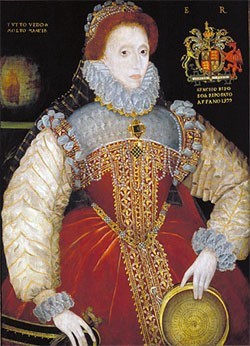
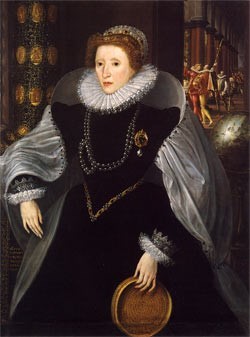
Fashions changed somewhat in the early 1580s with the square bodice finally disappearing and ruffs growing larger and more elaborate. This is reflected in the Ermine Portrait, also attributed to Hilliard, and dating from about 1585. In this painting, Elizabeth’s hair appears less natural, and may reflect that she favoured wigs as time passed. This wonderful painting was selected for the cover of the Tudor Times Queen Elizabeth I Book of Days. Once again, the symbolism emphasises chastity – the ermine was believed to be so protective of its purity, that it would die rather than soil its fur. Her central jewel is named The Three Brothers, consisting of three diamonds arranged in triangular fashion around a fourth. Presumably, this was a favourite jewel, as it is also shown on Elizabeth’s tomb monument. It is likely that the portrait was commissioned by the Cecils to commemorate a 1585 visit made by Elizabeth to their house at Theobalds, although the portrait is now at Hatfield House.
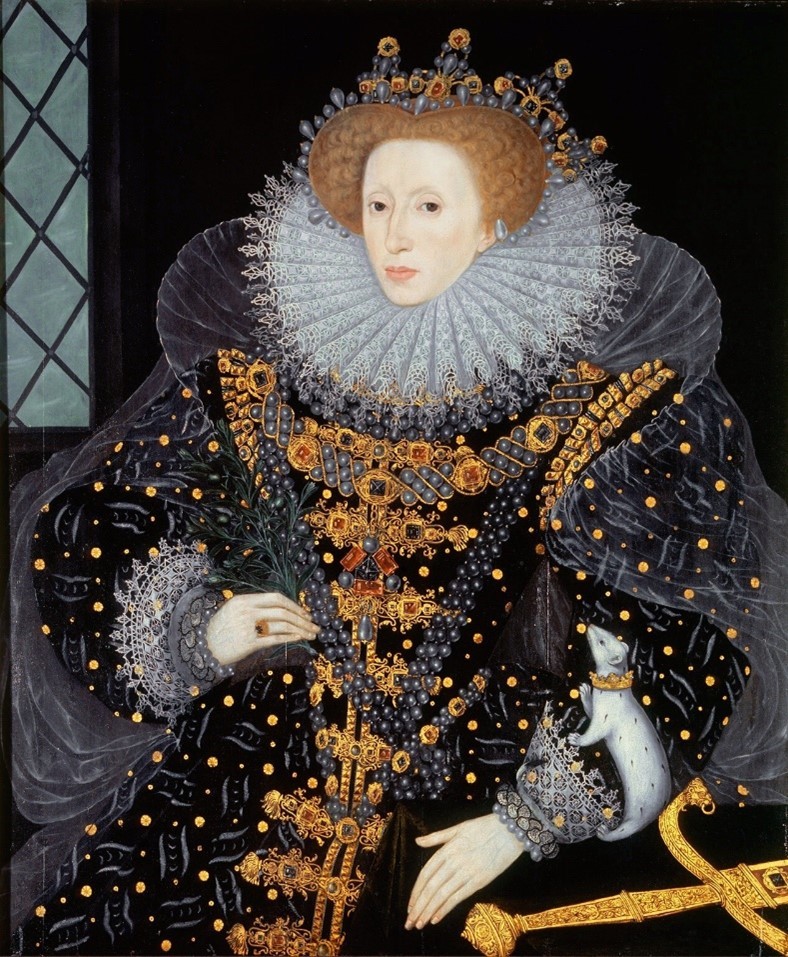
Some of the most famous portraits of the queen are those that commemorate the English victory over the Spanish Armada, in 1588. Three versions of a similar portrait are on show at the Queen’s House, part of the National Maritime Museum, Greenwich. It is possible that Sir Francis Drake commissioned one of the paintings, now known as the Tyrwhitt Drake version. Another, the best preserved, is that currently owned by the Duke of Bedford, at Woburn Abbey. Elizabeth has her right hand on a globe, demonstrating English superiority on the seas, and pretensions to expansion in the New World. Over her shoulders are, in various slightly different layouts in the different paintings, to the left, the victorious English fleet, and to the right, the storm-tossed and ship-wrecked Armada. Her crown is closed – which indicates imperial status. That is, Elizabeth is not subject to any higher earthly authority.
Following the triumph over the 1588 Armada, Elizabeth’s presentation as the Virgin Queen, as Gloriana and almost as a goddess, took flight. Although politically, the 1590s were full of troubles – famine, disease, continuing war with Spain, war in Ireland, parliamentary resentment of monopolies, and the increasing dissatisfaction of the Puritans with the established Church - these things tend to be outweighed in the perception of Elizabeth by the picture she and her counsellors wanted to portray.
A clear example of the propaganda surrounding the queen is the superb Ditchley Portrait by Marcus Gheerhaerts the Younger, dating from around 1592. The new fashion of the cartwheel farthingale and the open ruff with the veil behind show a queen at the forefront of fashion. There is no attempt to paint her realistically in space – instead, she is standing on a globe, again symbolising English expansionism, but with her slippered feet firmly on England, and probably pointing to Ditchley, Oxfordshire, the home of Sir Henry Lee, the royal champion, who commissioned the painting. He had incurred Elizabeth’s displeasure for living with Anne Vavasour, without benefit of matrimony. Elizabeth disliked any hint of sexual impropriety – it reflected badly on her. However, she had relented and accepted Lee’s hospitality in September 1592. In the background are various complimentary Latin inscriptions and a sonnet, possibly by Lee.
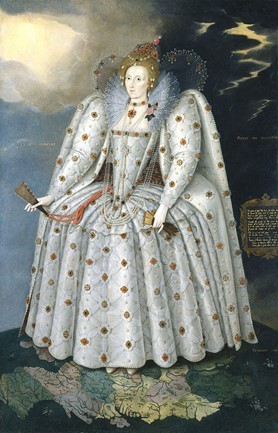
One of the final, yet most famous, paintings of Elizabeth, is that entitled Queen Elizabeth going in procession to Blackfriars. It shows the queen being carried in a litter, surrounded by courtiers, with adoring subjects watching either lined up in the street, or peering from windows above. It was probably commissioned by Edward Somerset, 4th Earl of Worcester, to celebrate his appointment in 1601 to the position of Master of the Horse – a post vacant following the Essex Rebellion. The figure in red immediately below Elizabeth has been identified as Worcester. It is attributed to Robert Peake, who was much favoured by Anne of Denmark, wife of Elizabeth’s successor. The background is not, as one might have expected, the Thames or a building in London, but has been copied from an engraving by Hieronymous Wierex, depicting the Sermon on the Mount and foreshadowing the destruction of the Temple. The two castles in the painting probably allude to Worcester’s properties at Raglan and Chepstow.
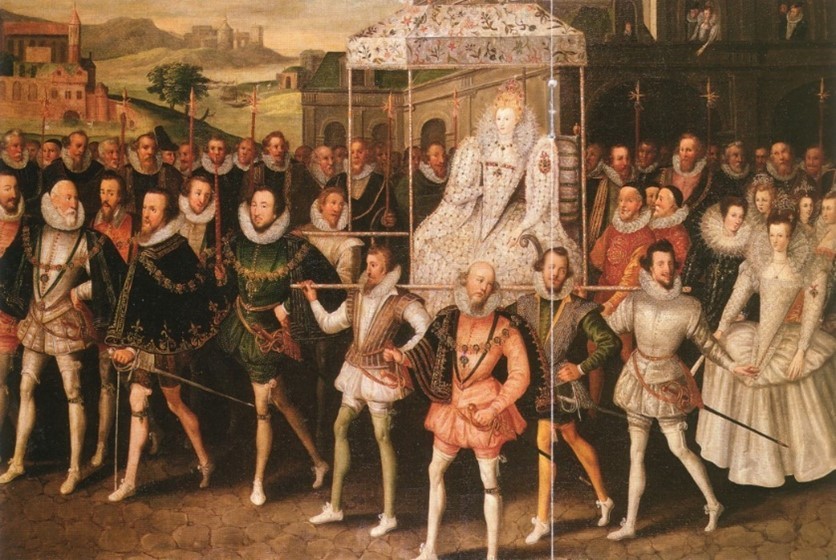
Perhaps the most wonderful painting of all, is that known as the Rainbow Portrait from 1601, probably commissioned by Elizabeth herself, or by her chief advisor, Sir Robert Cecil, son of Lord Burghley. The symbolism is rich and multilayered. The wildflowers on Elizabeth’s dress indicate she represents Astraea, an ancient Greek heroine, but that is not all. The serpent on her sleeve denotes wisdom and cunning, the eyes and ears denote her all-seeing, all-hearing knowledge of her kingdom and people; the rainbow in her hand, with the inscription ‘Non sine sole iris’, indicate that it is Elizabeth’s enlightened rule that brings peace and prosperity. The queen’s cloak wraps her round in a nod to robes worn by the goddesses of classical antiquity, whilst her loose hair again refers to virginity, and the gauzy veils lend an air of ethereality and timelessness. The face cannot have been painted directly from life, the queen being in her late sixties at the time, but probably is based on the approved portrait types from earlier decades. It is possible that the very gown she is wearing in the portrait, is that known as the Bacton Altar Cloth, which was recently ‘re-discovered’ and subject to extensive restoration by Historic Royal Palaces. The portrait itself remains in the ownership of the Cecil family.
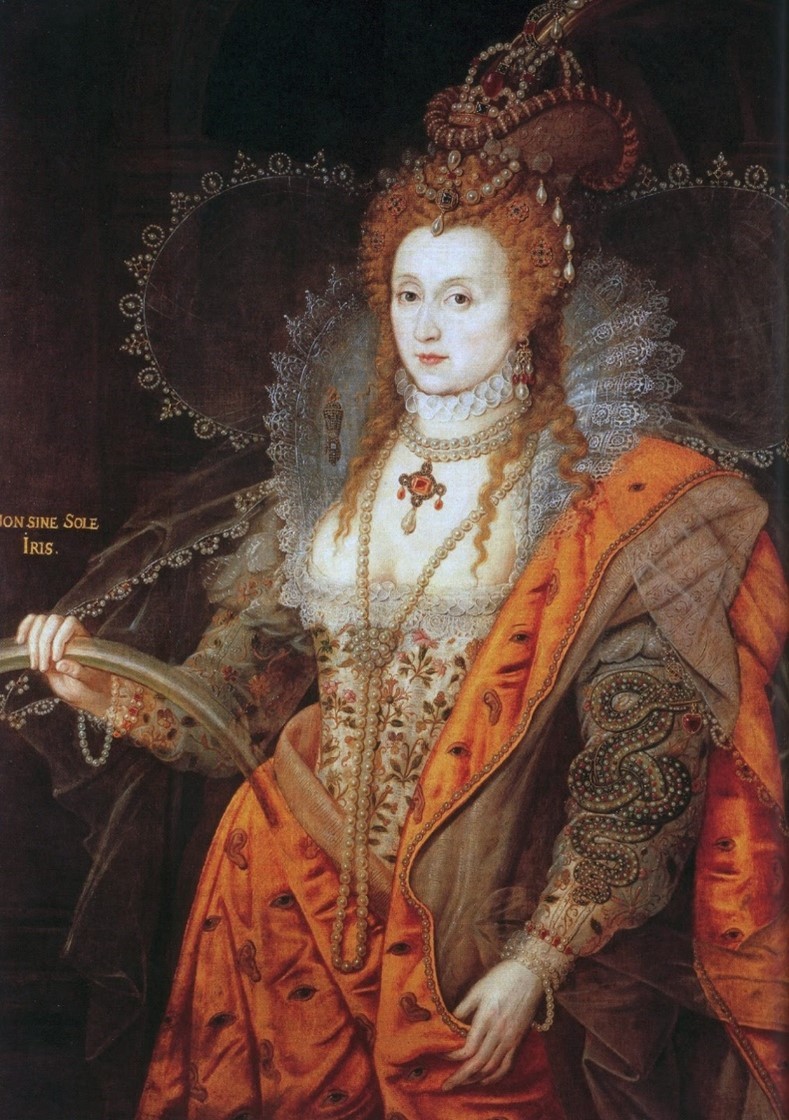
There are countless other portraits and engravings of Elizabeth, in books, in museums, and in the back corridors of country houses across England – to see them all would be a life’s work!
